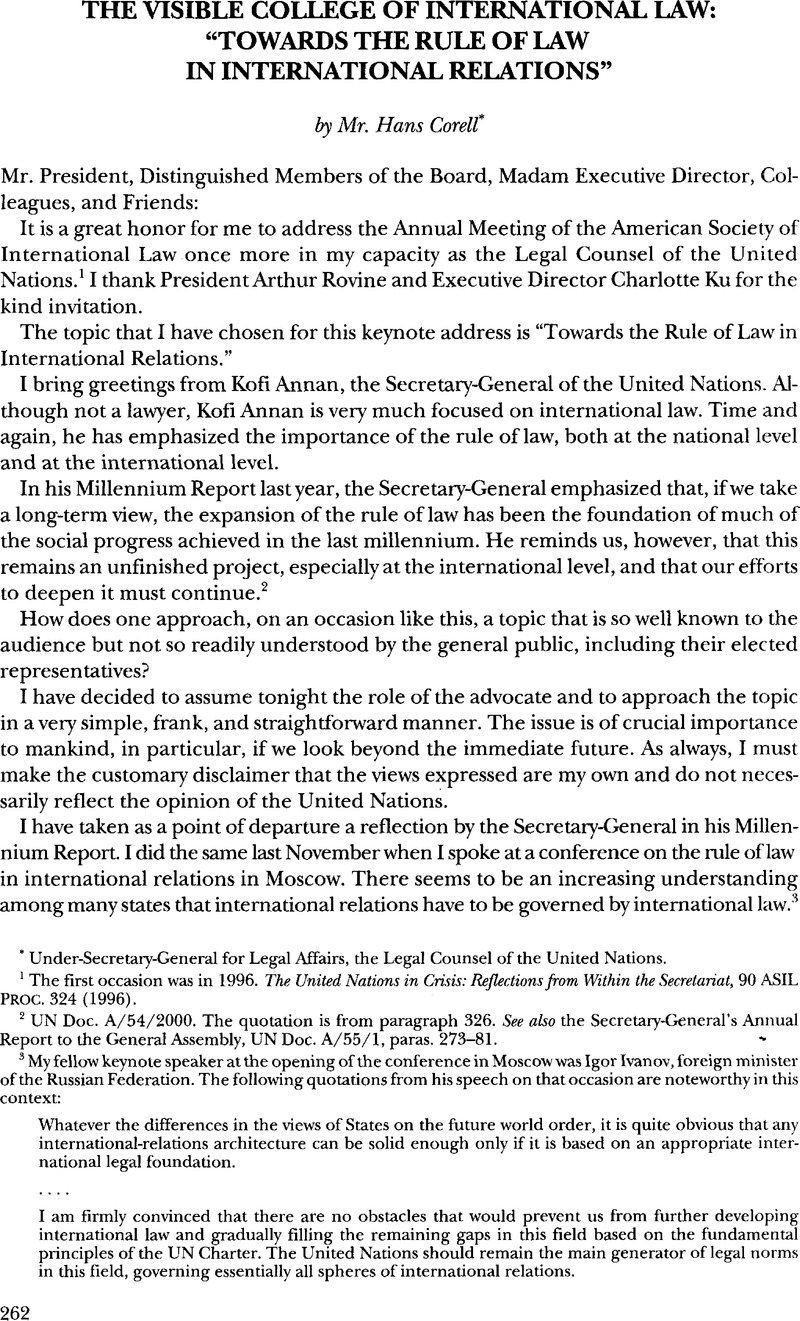Published online by Cambridge University Press: 28 February 2017

1 The first occasion was in 1996. The United Nations in Crisis: Reflections from Within the Secretariat, 90 ASIL Proc. 324 (1996).
2 UN Doc. A/54/2000. The quotation is from paragraph 326. See also the Secretary-General’s Annual Report to the General Assembly, UN Doc. A/55/1, paras. 273-81.
3 My fellow keynote speaker at the opening of the conference in Moscow was Igor Ivanov, foreign minister of the Russian Federation. The following quotations from his speech on that occasion are noteworthy in this context:
Whatever the differences in the views of States on the future world order, it is quite obvious that any international relations architecture can be solid enough only if it is based on an appropriate international legal foundation.
...
I am firmly convinced that there are no obstacles that would prevent us from further developing international law and gradually filling the remaining gaps in this field based on the fundamental principles of the UN Charter. The United Nations should remain the main generator of legal norms in this field, governing essentially all spheres of international relations.
...
Evolution of global and regional processes will undoubtedly require further development and adaptation of international law. For that reason, we favour the most active involvement of scientists and experts, representatives of non-governmental organizations and civil society as a whole in this creative process.
4 Anthony Lake, Six Nightmares (2000).
5 LAKE, supra note 4, at 215.
6 Id. at 234.
7 SirWatts, Arthur, The International Rule of Law. 36 Ger. Y. B. Int’l L. 15 (1993)Google Scholar. This writing provides an excellent overview of the questions relevant to the topic. See also Ian Brownlie, The Rule of Law in International Affairs: International Law at the Fiftieth Anniversary of the United Nations 1-17, 213-28 (1998).
8 UN CHARTER.
9 Id. Art. l, para. 1.
10 Id. Art. 1, para. 3.
11 GA Res. 55/2 (Sept. 8, 2000).
12 Id. para. 25; see also id. para. 26.
13 SC Res. 827 (May 25, 1993).
14 SC Res. 955 (Nov. 8, 1994).
15 SC Res. 1315 (Aug. 14, 2000).
16 Rome Statute of the International Criminal Court, July 17, 1998, UN Doc. A/CONF.183/9*, reprinted 37 ILM 999 (1998).
17 Such assistance is given inter alia by the Office of the High Commissioner for Human Rights; the Office of the High Commissioner for Refugees; the UN Environment Programme; the International Trade Law Branch of the Office of Legal Affairs; United Nations Development Programme; and United Nations Children’s Fund. See the icon “Technical Assistance” at <http://www.un.org/law>.
18 GA Res. 44/23. (Nov. 17, 1989).
19 At <http://www.un.org/law>.
20 At <http://untreaty.un.org>.
21 James F. Moore, The Death of Competition: Leadership and Strategy in the Age of Business Ecosystems (1996).
22 Id. at 277.
23 LAKE supra note 4, at 283.
24 Id. at 290.
25 Status as of 4 April 2001.
26 The Secretary-General’s Statement at the Ceremony on Campidoglio in Rome on July 18, 1998, at <http://www.un.org/icc/speeches/718sg.htm>.
27 See <http://www.un.org/Depts/los/index.htm>.
28 Corell, Hans, An Appeal to the Deans of Law Schools Worldwide, reprinted in ASIL Newsl. July-Aug. 2000, available at <http://www.un.org/law/counsel/info.htm>Google Scholar.
29 Id., supra note 28.
30 Hávamál, : The Sayings of the Vikings (Jónasson, Björn trans., Gudrun Publishing 1992)Google Scholar.